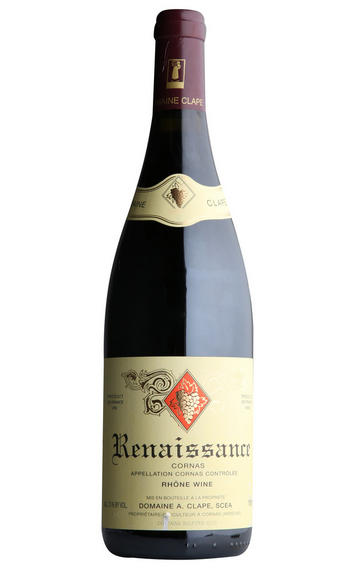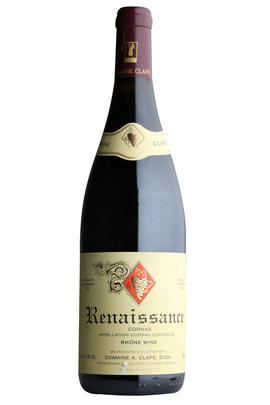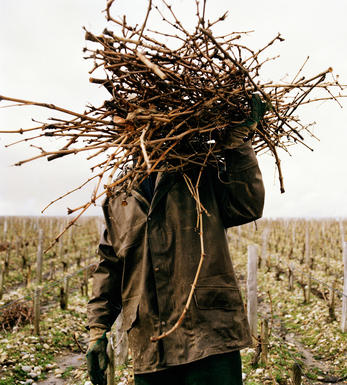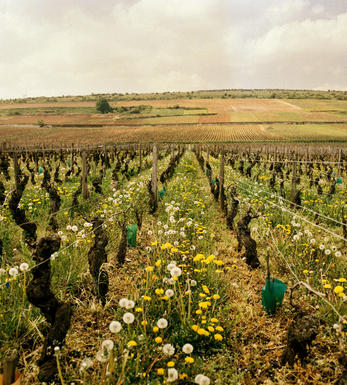
2018 Cornas, Renaissance, Domaine A. Clape, Rhône

Critics reviews
Josh Raynolds, Vinous (May 2020)
Jeb Dunnuck, jebdunnuck.com (Dec 2019)
About this WINE

Domaine Clape
Auguste Clape produces unquestionably the finest wines in Cornas from his minute cellars located on the RN98 in the middle of the appellation. He has 11 acres of vineyards, the majority being superbly well sited on the steep hillside surrounding the village. The average vine age is high, with some being over 100 years old.
The wines are vinified traditionally and are then matured in wooden barrels for 18 months. No new oak whatsoever is used. Clape`s wines tend to be opaque in colour, impenetrable on the nose and densely tannic when young. However, with age, the tannins soften and they develop a seductive perfume of creamy, peppery, black fruits, leading on to complex flavours and nuances on the palate. The best examples can last for 20-30 years. Auguste, who is now in his late 60s, is gradually passing over the reins to his son, Pierre-Marie.

Cornas
Cornas is a small appellation, just 150 hectares, located south of St Joseph. It’s on the west side of the river. The name “Cornas” comes from an old Celtic dialect term, meaning “burnt land”, so it’s no surprise that on the steep terraces here, facing south, temperatures are significantly higher than those in Hermitage, which is just 7km away.
The granite soils are home to the Syrah grape, producing reds that sit somewhere between those of Hermitage and Côte-Rôtie. These are strong and powerful wines, with nervy acidity and a robust, rustic charm to them. Their prominent tannins mean that they often demand time in the cellar to express their underlying elegance and complexity.

Syrah/Shiraz
A noble black grape variety grown particularly in the Northern Rhône where it produces the great red wines of Hermitage, Cote Rôtie and Cornas, and in Australia where it produces wines of startling depth and intensity. Reasonably low yields are a crucial factor for quality as is picking at optimum ripeness. Its heartland, Hermitage and Côte Rôtie, consists of 270 hectares of steeply terraced vineyards producing wines that brim with pepper, spices, tar and black treacle when young. After 5-10 years they become smooth and velvety with pronounced fruit characteristics of damsons, raspberries, blackcurrants and loganberries.
It is now grown extensively in the Southern Rhône where it is blended with Grenache and Mourvèdre to produce the great red wines of Châteauneuf du Pape and Gigondas amongst others. Its spiritual home in Australia is the Barossa Valley, where there are plantings dating as far back as 1860. Australian Shiraz tends to be sweeter than its Northern Rhône counterpart and the best examples are redolent of new leather, dark chocolate, liquorice, and prunes and display a blackcurrant lusciousness.
South African producers such as Eben Sadie are now producing world- class Shiraz wines that represent astonishing value for money.


Buying options
Add to wishlist
Description
Powerful, mineral-driven aromas of ripe black/blue fruits, candied flowers, olive, musky earth and exotic spices. Densely packed and animated on the palate, offering bitter cherry, blueberry and spicecake flavors that unwind slowly with air and show fine delineation. The blue fruit and floral notes drive an impressively long, spice-laced finish that's given shape by fine-grained, slowly building tannins.
Josh Raynolds, Vinous (May 2020)
wine at a glance
Delivery and quality guarantee